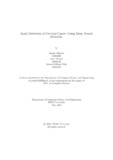| dc.contributor.advisor | Alam, Md. Ashraful | |
| dc.contributor.advisor | Reza, Md. Tanzim | |
| dc.contributor.author | Akhund, Atoshi | |
| dc.contributor.author | Ahmad, Saad | |
| dc.contributor.author | Taki, Sarwar Siddiqui | |
| dc.date.accessioned | 2023-04-06T05:26:27Z | |
| dc.date.available | 2023-04-06T05:26:27Z | |
| dc.date.copyright | 2022 | |
| dc.date.issued | 2022-05 | |
| dc.identifier.other | ID 18201199 | |
| dc.identifier.other | ID 18101226 | |
| dc.identifier.other | ID 18101193 | |
| dc.identifier.uri | http://hdl.handle.net/10361/18093 | |
| dc.description | This thesis is submitted in partial fulfillment of the requirements for the degree of Bachelor of Science in Computer Science, 2022. | en_US |
| dc.description | Cataloged from PDF version of thesis. | |
| dc.description | Includes bibliographical references (pages 30-33). | |
| dc.description.abstract | Cervical cancer is a disease that is mostly preventable, but it is one of the major
causes of cancer fatality in women worldwide. Several studies say that annually
2,60,000 women die because of cervical cancer. Chronic infections with ”high-risk
(HR)” human papillomavirus are the leading cause of cervical cancer (HPV). Regular
cervical cancer screening, on the other hand, can help to prevent this dangerous
disease. Cervical cancer screening is a procedure for detecting precancerous and
cancer in women who are at risk, and it is recommended for all women aged 30 to
49. Cervical cancer can be avoided if precancerous lesions are detected and treated
early. Nowadays, several tests are performed to detect cervical cancer, most of
whom are time consuming and expensive. In this paper, we are approaching the
development of a fast and effective system to detect cervical cancer from the cervix
image in a minimum time with better accuracy using deep neural networks. First,
we collected image data and classified them using VGG16, VGG19, InceptionV3,
ResNet50 and ResNet101. From our result we got an accuracy rate of 88.48% from
VGG16, 88.97% from VGG19, 88.09% from InceptionV3, 88.67% from ResNet50
and 89.06% from ResNet101. Then, using a mixture of classifiers with the greatest
accuracy, we created ensemble models with the best overall accuracy rate of 94.20
percent for CERVIXEN V1, 95.01 percent for CERVIXEN V2, and 94.69 percent
for CERVIXEN V3. | en_US |
| dc.description.statementofresponsibility | Atoshi Akhund | |
| dc.description.statementofresponsibility | Saad Ahmad | |
| dc.description.statementofresponsibility | Sarwar Siddiqui Taki | |
| dc.format.extent | 33 pages | |
| dc.language.iso | en | en_US |
| dc.publisher | Brac University | en_US |
| dc.rights | Brac University theses are protected by copyright. They may be viewed from this source for any purpose, but reproduction or distribution in any format is prohibited without written permission. | |
| dc.subject | Cervical cancer | en_US |
| dc.subject | HPV | en_US |
| dc.subject | Precancerous lesions | en_US |
| dc.subject | Cervix image | en_US |
| dc.subject | Deep neural network | en_US |
| dc.subject | VGG | en_US |
| dc.subject | ResNet | en_US |
| dc.subject | Inception | en_US |
| dc.subject.lcsh | Neural networks (Computer science) | |
| dc.subject.lcsh | Cervix uteri--Cancer--Diagnosis | |
| dc.title | Early detection of cervical cancer using deep neural networks | en_US |
| dc.type | Thesis | en_US |
| dc.contributor.department | Department of Computer Science and Engineering, Brac University | |
| dc.description.degree | B. Computer Science | |

